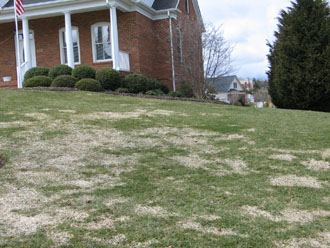Snow Mold
Has snow mold invaded your lawn? What it really is and what you should or should not do to prevent, stop, and/or repair further damage.

Related Links
Following winters with extended snowfall it is very likely that cool-season (and even the dormant warm-season) lawn grasses have been attacked by either pink (causal agent is Microdochium nivale) or gray (causal agent is Typhula incarnata) snow mold. The blighted turf will be a circular patch of matted down turf of varying size. The fungi that incite the disease lie dormant in the soil and turf canopy for most of the year but become active under high humidity conditions when the temperatures are just above freezing—the exact conditions at soil level when there is persistent snow cover (and in some years, it occurs even without snow). The diseases are more likely to occur on succulent turfgrass leaves that received very high levels of fall Nitrogen fertilization.
While it is highly likely that golf superintendents will spray a preventive fungicide program on their putting greens to control these diseases, it is not generally recommended that home lawns be treated because the disease is rarely going to kill turf in this setting, especially warm-season grasses. If a lawn has a history of snow mold diseases, then a preventive program that is initiated in the fall with a standard broad-spectrum fungicide such as triadimefon (e.g. Bayleton) can be applied (see the Virginia Tech Pest Management Guide, Publication 456-018, that can be found by searching the VT website at www.VT.edu).
What can you do in the spring with the patches in the lawn? For warm-season grasses, do nothing. The disease has basically been infesting dormant leaves and will not have caused long-term problems. However, there has been significant damage to cool-season grasses that needs to be addressed. Use a heavy garden rake to work up the matted turf in the affected areas in order to increase air and moisture movement into the turf canopy. While snow molds can kill turf completely to the crown (i.e. its growing points), they most often only attack the leaves, thus leaving an eyesore for the lawn, but one that has potential for regrowth. Observe the area over the next 7 days or so to see if new shoots are emerging from the crowns. If you see some regrowth, you might give the turf a light feeding of Nitrogen to promote recovery. Only 0.25 to 0.5 lb N/1000 sq ft is warranted, with the total goal for spring N fertilization not to exceed 1 lb N/1000 sq ft. If you don’t see any signs of new growth after that time period, then plan on reseeding these areas. Once again, rake/scratch the affected area with a heavy garden rake, sprinkle an appropriate grass seed on the area that matches your lawn, and rake/scratch the area one more time to encourage soil to seed contact. How much seed? It is difficult to ‘calibrate’ spot seedings but the rule of thumb is to be careful not to ‘bury’ the spot in seed; you should still be able to see the soil/turf canopy under the seed. So, a sprinkling of seed using the method often referred to as ‘feeding the chickens’ is an appropriate seeding strategy.
Snow molds are not nearly as big of a problem in Virginia and mid-Atlantic lawns as they are further north. However, when they occur they certainly attract a lot of attention. They are simply another reminder of the power and diversity of Mother Nature.
About this File
Author: Mike Goatley
Release Date: March 19, 2010
Length: 03:15
Link: Snow Mold
Contact Turf and Garden Tips
Please contact your local Extension office for more information related to your turf and garden questions.


